2017 PEUGEOT 5008 engine oil
[x] Cancel search: engine oilPage 9 of 404
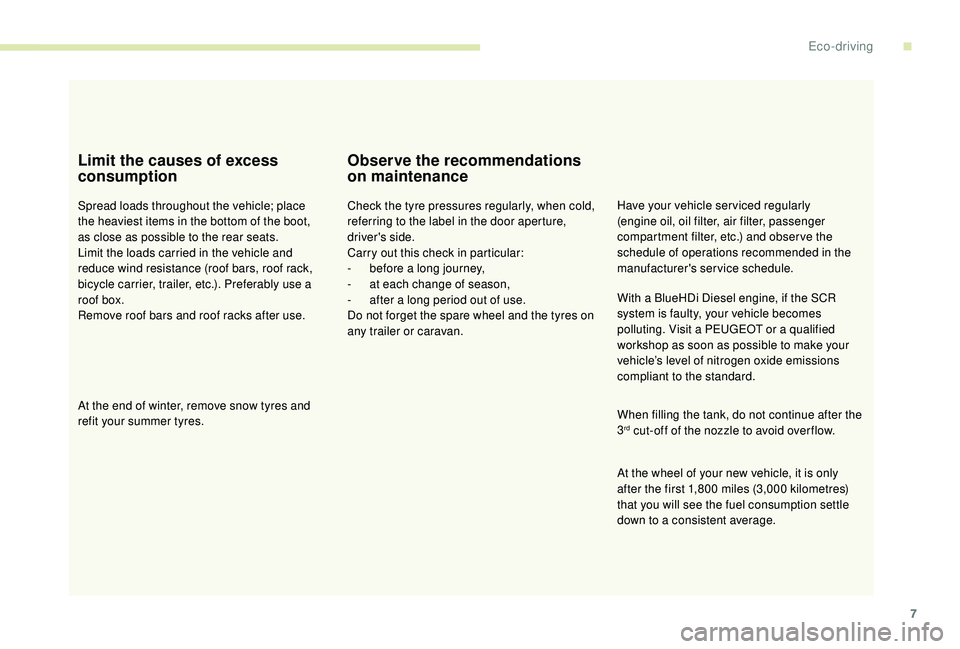
7
Limit the causes of excess
consumption
Spread loads throughout the vehicle; place
the heaviest items in the bottom of the boot,
as close as possible to the rear seats.
Limit the loads carried in the vehicle and
reduce wind resistance (roof bars, roof rack,
bicycle carrier, trailer, etc.). Preferably use a
roof box.
Remove roof bars and roof racks after use.
At the end of winter, remove snow tyres and
refit your summer tyres.
Observe the recommendations
on maintenance
Check the tyre pressures regularly, when cold,
referring to the label in the door aperture,
driver's side.
Carry out this check in particular:
-
b
efore a long journey,
-
a
t each change of season,
-
a
fter a long period out of use.
Do not forget the spare wheel and the tyres on
any trailer or caravan. Have your vehicle ser viced regularly
(engine oil, oil filter, air filter, passenger
compartment filter, etc.) and obser ve the
schedule of operations recommended in the
manufacturer's service schedule.
When filling the tank, do not continue after the
3
rd cut-off of the nozzle to avoid over flow.
At the wheel of your new vehicle, it is only
after the first 1,800
miles (3,000 kilometres)
that you will see the fuel consumption settle
down to a consistent average. With a BlueHDi Diesel engine, if the SCR
system is faulty, your vehicle becomes
polluting. Visit a PEUGEOT or a qualified
workshop as soon as possible to make your
vehicle’s level of nitrogen oxide emissions
compliant to the standard.
.
Eco-driving
Page 13 of 404
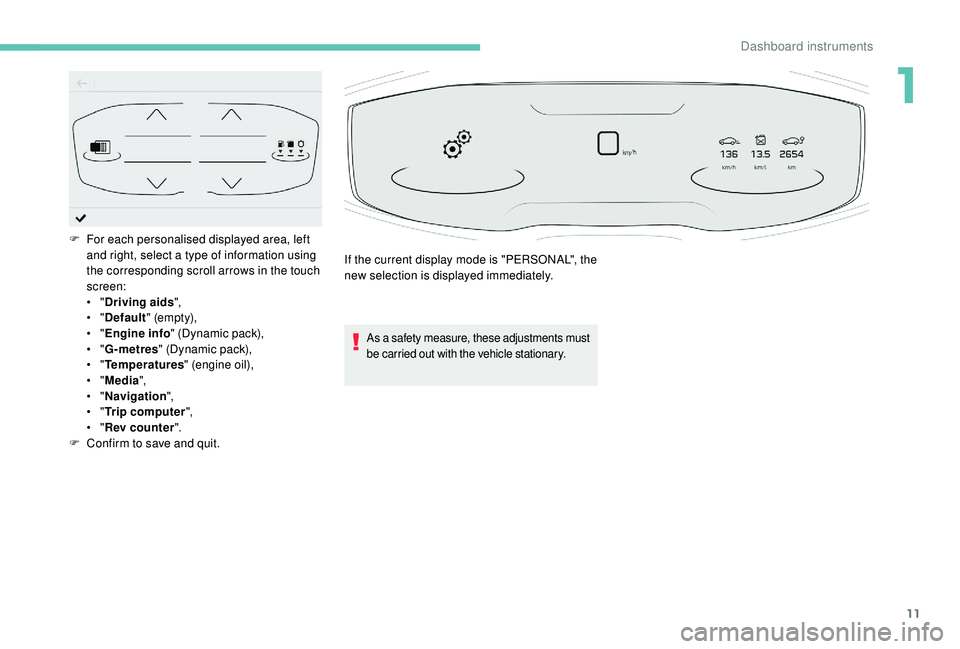
11
As a safety measure, these adjustments must
be carried out with the vehicle stationary.
F For each personalised displayed area, left and right, select a type of information using
the corresponding scroll arrows in the touch
screen:
•
"Driving aids ",
•
"Default " (empt y),
•
"Engine info " (Dynamic pack),
•
"G-metres " (Dynamic pack),
•
"Temperatures " (engine oil),
•
"Media ",
•
"Navigation ",
•
"Trip computer ",
•
"Rev counter ".
F
C
onfirm to save and quit. If the current display mode is "PERSONAL", the
new selection is displayed immediately.
1
Dashboard instruments
Page 15 of 404
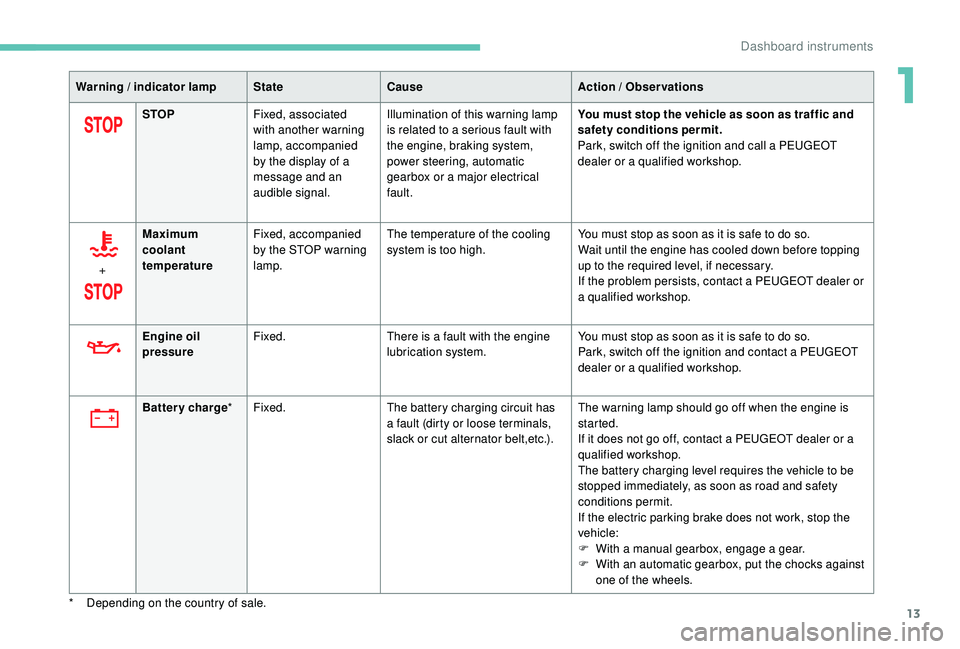
13
Warning / indicator lampStateCause Action / Observations
STOP Fixed, associated
with another warning
lamp, accompanied
by the display of a
message and an
audible signal. Illumination of this warning lamp
is related to a serious fault with
the engine, braking system,
power steering, automatic
gearbox or a major electrical
fault. You must stop the vehicle as soon as traffic and
safety conditions permit.
Park, switch off the ignition and call a PEUGEOT
dealer or a qualified workshop.
+ Maximum
coolant
temperature
Fixed, accompanied
by the STOP warning
lamp. The temperature of the cooling
system is too high.
You must stop as soon as it is safe to do so.
Wait until the engine has cooled down before topping
up to the required level, if necessary.
If the problem persists, contact a PEUGEOT dealer or
a qualified workshop.
*
D
epending on the country of sale. Battery charge
*Fixed. The battery charging circuit has
a fault (dirty or loose terminals,
slack or cut alternator belt,etc.). The warning lamp should go off when the engine is
started.
If it does not go off, contact a PEUGEOT dealer or a
qualified workshop.
The battery charging level requires the vehicle to be
stopped immediately, as soon as road and safety
conditions permit.
If the electric parking brake does not work, stop the
vehicle:
F
W
ith a manual gearbox, engage a gear.
F
W
ith an automatic gearbox, put the chocks against
one of the wheels.
Engine oil
pressure
Fixed.
There is a fault with the engine
lubrication system. You must stop as soon as it is safe to do so.
Park, switch off the ignition and contact a PEUGEOT
dealer or a qualified workshop.
1
Dashboard instruments
Page 32 of 404
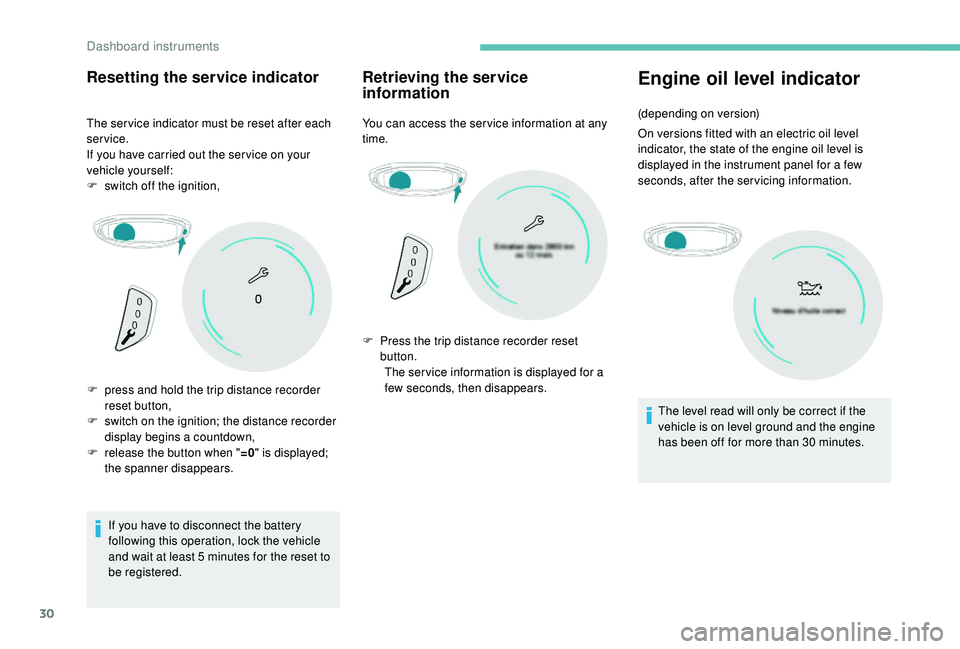
30
Resetting the service indicator
The ser vice indicator must be reset after each
service.
If you have carried out the ser vice on your
vehicle yourself:
F
s
witch off the ignition,
If you have to disconnect the battery
following this operation, lock the vehicle
and wait at least 5
minutes for the reset to
be registered.
Retrieving the service
information
You can access the ser vice information at any
time.
Engine oil level indicator
F press and hold the trip distance recorder reset button,
F
s
witch on the ignition; the distance recorder
display begins a countdown,
F
r
elease the button when " =0" is displayed;
the spanner disappears. F
P
ress the trip distance recorder reset
button. The ser vice information is displayed for a
few seconds, then disappears. (depending on version)
On versions fitted with an electric oil level
indicator, the state of the engine oil level is
displayed in the instrument panel for a few
seconds, after the servicing information.
The level read will only be correct if the
vehicle is on level ground and the engine
has been off for more than 30 minutes.
Dashboard instruments
Page 33 of 404
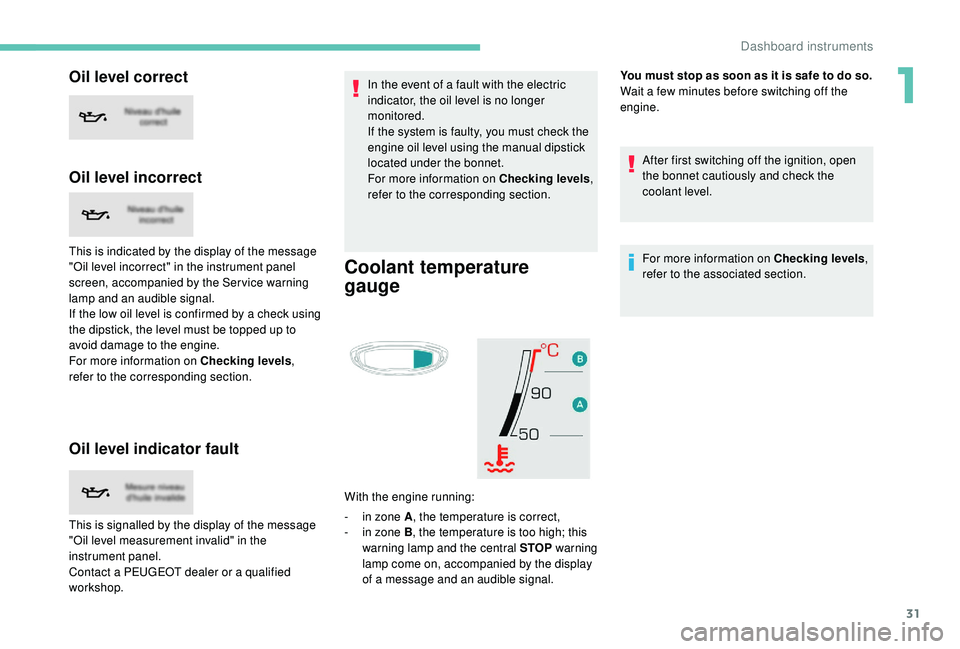
31
Oil level correct
Oil level incorrect
This is indicated by the display of the message
"Oil level incorrect" in the instrument panel
screen, accompanied by the Ser vice warning
lamp and an audible signal.
If the low oil level is confirmed by a check using
the dipstick, the level must be topped up to
avoid damage to the engine.
For more information on Checking levels,
refer to the corresponding section.
Oil level indicator fault
Coolant temperature
gauge
With the engine running:
-
i
n zone A , the temperature is correct,
-
i
n zone B , the temperature is too high; this
warning lamp and the central STOP warning
lamp come on, accompanied by the display
of a message and an audible signal. You must stop as soon as it is safe to do so.
Wait a few minutes before switching off the
engine.
After first switching off the ignition, open
the bonnet cautiously and check the
coolant level.
For more information on Checking levels ,
refer to the associated section.
This is signalled by the display of the message
"Oil level measurement invalid" in the
instrument panel.
Contact a PEUGEOT dealer or a qualified
workshop. In the event of a fault with the electric
indicator, the oil level is no longer
monitored.
If the system is faulty, you must check the
engine oil level using the manual dipstick
located under the bonnet.
For more information on Checking levels
,
refer to the corresponding section.
1
Dashboard instruments
Page 36 of 404
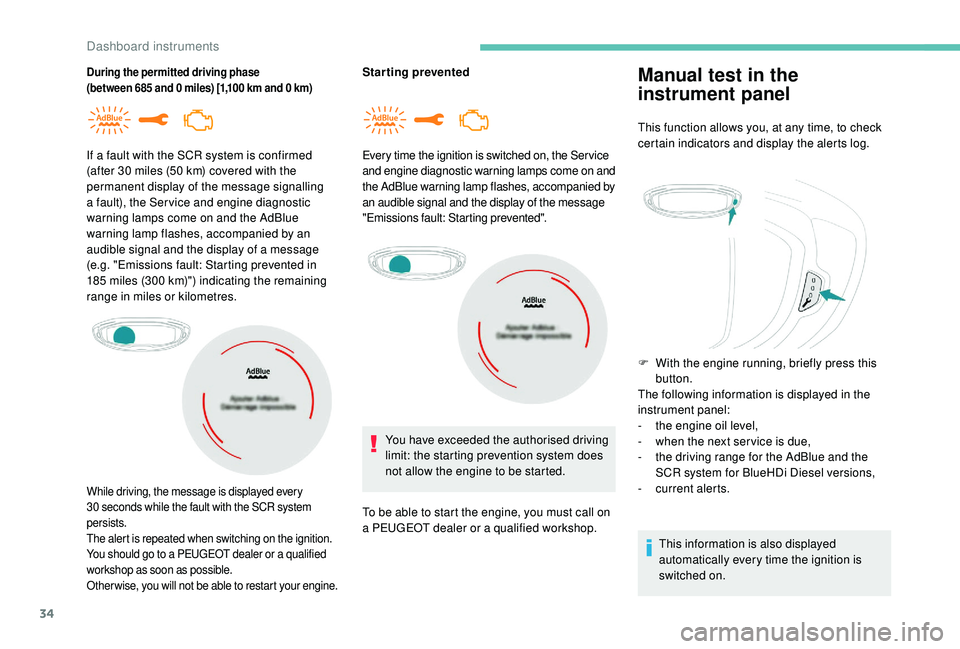
34
During the permitted driving phase
(between 685 and 0 miles) [1,100 km and 0 km)Starting prevented
If a fault with the SCR system is confirmed
(after 30
miles (50
km) covered with the
permanent display of the message signalling
a fault), the Ser vice and engine diagnostic
warning lamps come on and the AdBlue
warning lamp flashes, accompanied by an
audible signal and the display of a message
(e.g. "Emissions fault: Starting prevented in
185
miles (300
km)") indicating the remaining
range in miles or kilometres.
While driving, the message is displayed every
30 seconds while the fault with the SCR system
persists.
The alert is repeated when switching on the ignition.
You should go to a PEUGEOT dealer or a qualified
workshop as soon as possible.
Other wise, you will not be able to restart your engine.
Every time the ignition is switched on, the Ser vice
and engine diagnostic warning lamps come on and
the AdBlue warning lamp flashes, accompanied by
an audible signal and the display of the message
"Emissions fault: Starting prevented".
You have exceeded the authorised driving
limit: the starting prevention system does
not allow the engine to be started.
To be able to start the engine, you must call on
a PEUGEOT dealer or a qualified workshop.
Manual test in the
instrument panel
This function allows you, at any time, to check
certain indicators and display the alerts log.
F
W
ith the engine running, briefly press this
button.
The following information is displayed in the
instrument panel:
-
t
he engine oil level,
-
w
hen the next ser vice is due,
-
t
he driving range for the AdBlue and the
SCR system for BlueHDi Diesel versions,
-
c
urrent alerts.
This information is also displayed
automatically every time the ignition is
switched on.
Dashboard instruments
Page 249 of 404
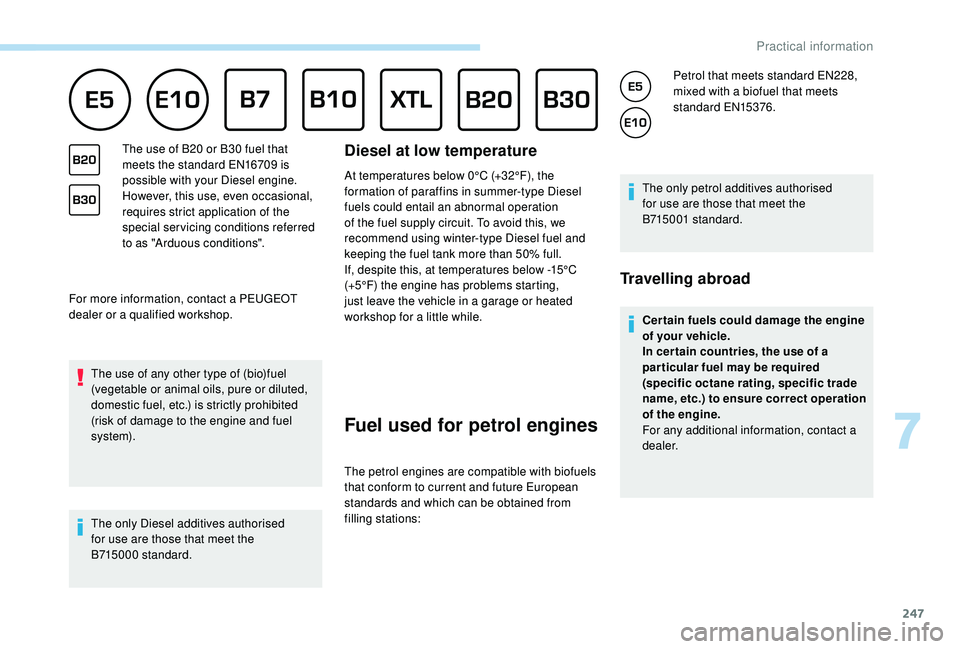
247
For more information, contact a PEUGEOT
dealer or a qualified workshop.The use of any other type of (bio)fuel
(vegetable or animal oils, pure or diluted,
domestic fuel, etc.) is strictly prohibited
(risk of damage to the engine and fuel
syste m).
The only Diesel additives authorised
for use are those that meet the
B715000
standard.
Diesel at low temperatureThe use of B20 or B30 fuel that
m eets the standard EN16709 is
possible with your Diesel engine.
However, this use, even occasional,
requires strict application of the
special servicing conditions referred
to as "Arduous conditions". At temperatures below 0°C (+32°F), the
formation of paraffins in summer-type Diesel
fuels could entail an abnormal operation
of the fuel supply circuit. To avoid this, we
recommend using winter-type Diesel fuel and
keeping the fuel tank more than 50% full.
If, despite this, at temperatures below -15°C
(+5°F) the engine has problems starting,
just leave the vehicle in a garage or heated
workshop for a little while.
Fuel used for petrol engines
The petrol engines are compatible with biofuels
that conform to current and future European
standards and which can be obtained from
filling stations: Petrol that meets standard EN228,
mixed with a biofuel that meets
standard EN15376.
The only petrol additives authorised
for use are those that meet the
B715001
standard.
Travelling abroad
Cer tain fuels could damage the engine
of your vehicle.
In cer tain countries, the use of a
par ticular fuel may be required
(specific octane rating, specific trade
name, etc.) to ensure correct operation
of the engine.
For any additional information, contact a
dealer.
7
Practical information
Page 259 of 404
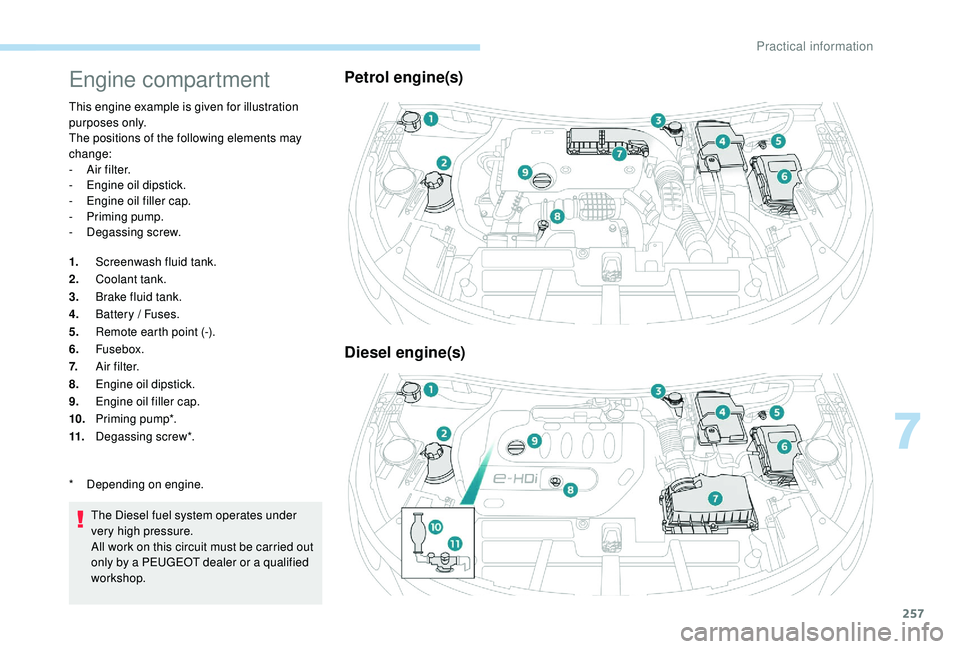
257
Engine compartment
This engine example is given for illustration
purposes only.
The positions of the following elements may
change:
-
A
ir filter.
-
E
ngine oil dipstick.
-
E
ngine oil filler cap.
-
P
riming pump.
-
D
egassing screw.
1. Screenwash fluid tank.
2. Coolant tank.
3. Brake fluid tank.
4. Battery / Fuses.
5. Remote earth point (-).
6. Fusebox.
7. A i r f i l t e r.
8. Engine oil dipstick.
9. Engine oil filler cap.
10. Priming pump*.
11. Degassing screw*.
The Diesel fuel system operates under
very high pressure.
All work on this circuit must be carried out
only by a PEUGEOT dealer or a qualified
workshop.
Petrol engine(s)
Diesel engine(s)
* Depending on engine.
7
Practical information